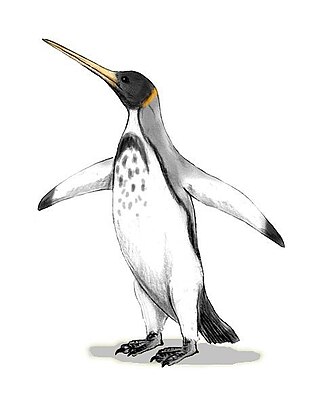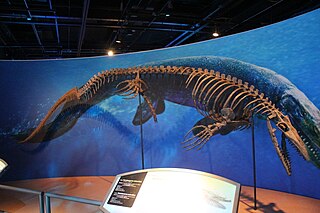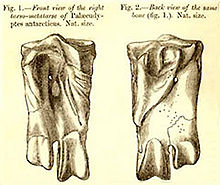
Penguins are a group of aquatic flightless birds from the family Spheniscidae of the order Sphenisciformes. They live almost exclusively in the Southern Hemisphere: only one species, the Galápagos penguin, is found north of the Equator. Highly adapted for life in the ocean water, penguins have countershaded dark and white plumage and flippers for swimming. Most penguins feed on krill, fish, squid and other forms of sea life which they catch with their bills and swallow whole while swimming. A penguin has a spiny tongue and powerful jaws to grip slippery prey.
Archaeospheniscus is an extinct genus of large penguins. It currently contains three species, known from somewhat fragmentary remains. A. wimani, the smallest species, was found in Middle or Late Eocene strata of the La Meseta Formation on Seymour Island, Antarctica, whereas the other two, about the size of a modern emperor penguin, are known from bones recovered from the Late Oligocene Kokoamu Greensand Formation at Duntroon, New Zealand.

Paraptenodytes is an extinct genus of penguins which contains two or three species sized between a Magellanic penguin and an emperor penguin. They are known from fossil bones ranging from a partial skeleton and some additional material in the case of P. antarcticus, the type specimen for the genus, and a single humerus in the case of P. brodkorbi. The latter species is therefore often considered invalid; a recent study considers it indeed valid, but distinct enough not to belong into Paraptenodytes. The fossils were found in the Santa Cruz and Chubut Provinces of Patagonia, Argentina, in the Gaiman, Monte León and Santa Cruz Formations of Early to Middle Miocene age. Later occurrences are apparently from Late Miocene or possibly even Early Pliocene deposits.
Palaeeudyptinae, the giant penguins, is a paraphyletic subfamily of prehistoric penguins. It includes several genera of medium-sized to very large species, such as Icadyptes salasi, Palaeeudyptes marplesi, Anthropornis nordenskjoeldi, and Pachydyptes ponderosus. Icadyptes reached 1.5 m in height, while members of Palaeeudyptes and Anthropornis grew even taller and were some of the largest penguins to have ever existed. The massive P. ponderosus may have weighed at least as much as an adult human.
Archaeospheniscus wimani is an extinct species of penguin. It was the smallest species of the genus Archaeospheniscus, being approximately 75 to 85 centimetres high, or about the size of a gentoo penguin. It is also the oldest known species of its genus, as its remains were found in Middle or Late Eocene strata of the La Meseta Formation on Seymour Island, Antarctica. It is known from a fair number of bones.
Archaeospheniscus lopdelli was the largest species of the extinct penguin genus Archaeospheniscus, standing about 90–120 cm (35–47 in) high, or somewhat less than the extant emperor penguin. It is only known from bones of a single individual which was found in the Late Oligocene Kokoamu Greensand Formation at Duntroon, New Zealand. Bones apparently belonging to this species are now also known from the Late Eocene La Meseta Formation on Seymour Island, Antarctica.

Palaeeudyptes antarcticus, also referred to as the narrow-flippered penguin, is the type species of the extinct penguin genus Palaeeudyptes. It was a huge species, albeit probably with a large size variation. Although the size range can only be loosely estimated, the birds seem to have stood between 43 and 55 inches high in life, placing this species and its congener Palaeeudyptes marplesi among the largest penguin species known. It was the last known Palaeeudyptes species, and although the exact time when it lived is not precisely determined, it may have evolved from P. marplesi, or they might even have been a single species which slightly decreased in size over time.
Marples' penguin was a large species of the extinct penguin genus Palaeeudyptes.
Palaeeudyptes gunnari is an extinct species of the extinct penguin genus Palaeeudyptes. It was a bit smaller than its congener Palaeeudyptes antarcticus of New Zealand, standing between 110 and 125 cm high, approximately the size of the emperor penguin. It is known from dozens of fossil bones from Middle or Late Eocene strata of the La Meseta Formation on Seymour Island, Antarctica. Initially, it was described as a separate genus, Eosphaeniscus. However, this was based on a single weathered and broken tarsometatarsus. Better material recovered later showed that the species belongs into the present genus.
Palaeeudyptes klekowskii is an extinct species of the penguin genus Palaeeudyptes. It was previously thought to have been approximately the size of its congener Palaeeudyptes antarcticus, somewhat larger than the modern emperor penguin, but a 2014 study showed it was in fact almost twice as tall, earning it the nickname “Mega Penguin”. Its maximum length is estimated to be up to 2 meters (6.6 ft) and maximum body mass up to 116 kg (256 lb). Knowledge of it comes from an extensive collection of fossil bones from the Late Eocene of the La Meseta Formation on Seymour Island, Antarctica. P. klekowskii was at first not recognized as a distinct species, and despite the coexistence of two so closely related species of similar size as Palaeeudyptes gunnari and P. klekowskii seeming somewhat improbable, the amount of fossil material suggests that the two species are indeed diagnosably different.
Paraptenodytes brodkorbi is a proposed, but possibly invalid, species of extinct penguin in the genus Paraptenodytes. The bird was probably about the size of a king penguin. Known material is limited to a single humerus, Early Miocene in age, found in the Monte León Formation near Puerto San Julián in Santa Cruz Province, Argentina. It exists as an unnumbered specimen in the collection of the Museo Argentino de Ciencias Naturales.

Seymour Island or Marambio Island, is an island in the chain of 16 major islands around the tip of the Graham Land on the Antarctic Peninsula. Graham Land is the closest part of Antarctica to South America. It lies within the section of the island chain that resides off the west side of the peninsula's northernmost tip. Within that section, it is separated from Snow Hill Island by Picnic Passage, and sits just east of the larger key, James Ross Island, and its smaller, neighboring island, Vega Island.

Icadyptes is an extinct genus of giant penguins from the Late Eocene tropics of South America.
Anatalavis is genus of prehistoric birds related to ducks and geese, perhaps to the magpie-goose in particular. Alternatively, it might have been a more basal lineage of Anserimorphae distinct from the living waterfowl, similar or even related to the roughly contemporary Conflicto antarcticus from the Danian of Antarctica.

Taniwhasaurus is an extinct genus of mosasaurs that lived during the Campanian stage of the Late Cretaceous. It is a member of the subfamily Tylosaurinae, a lineage of mosasaurs characterized by a long toothless conical rostrum. Two valid species are attached to the genus, T. oweni and T. antarcticus, known respectively from the fossil record of present-day New Zealand and Antarctica. Two other species have been nominally classified within the genus, T. 'capensis' and T. 'mikasaensis', recorded in present-day South Africa and Japan, but their attribution remains problematic due to the fragmentary state of their fossils. The generic name literally means "taniwha lizard", referring to a supernatural aquatic creature from Māori mythology.

Dasornis is a genus of prehistoric pseudotooth birds. These were probably close relatives of either pelicans and storks or waterfowl; they are placed in the order Odontopterygiformes to account for this uncertainty.

Kairuku is an extinct genus of penguin. It contains three species, K. grebneffi, K. waitaki and K. waewaeroa. This taxon is known from bones from 27 MYA, from the Kokoamu Greensand Formation of New Zealand. It was historically referred to as Palaeeudyptes.

The La Meseta Formation is a sedimentary sequence deposited during the Eocene on Seymour Island off the coast of the Antarctic Peninsula. It is noted for its fossils, which include both marine organisms and the only terrestrial vertebrate fossils from the Cenozoic of Antarctica.
Australornis is a genus of extinct seabird discovered in New Zealand. It lived in the Paleocene epoch, 60.5 to 61.6 million years ago (Ma). The type species name originates from australis, Latin for "southern", and ornis, the Greek word for "bird", and lovei commemorates Leigh Love, an amateur paleontologist who discovered it.
Platydyptes is a genus of extinct penguins from the Late Oligocene to Early Miocene of New Zealand. It was created by Brian Marples in 1952 and contains three relatively large species, all of which were described from the north Otago to south Canterbury region in the South Island. The genus name Platydyptes combines the Greek platys, alluding to the shape of the humerus, with dyptes ("diver").








